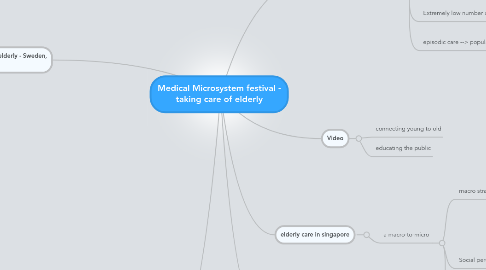
1. The Challenge of caring for people as they got older: US perspectives
1.1. Demographics
1.1.1. population
1.1.1.1. Simple chronic disease (e.g. diabetes)
1.1.1.2. Complex chronic (e.g. COPD and depression
1.1.1.3. end of life
1.1.2. policy
1.2. Patient/person view
1.2.1. whole person and personal caring
1.2.2. -- missed some points
1.3. Microsystems
1.3.1. primary care
1.3.2. hospital
1.3.3. assisted
1.3.4. homecare
1.4. Mesosystem
1.4.1. microsystems there when needed, patient in center
1.5. Models
1.5.1. IORA
1.5.1.1. Team effective for Simple chronic patients
1.5.1.1.1. 2 MDs
1.5.1.1.2. 4-8 health coaches
1.5.1.1.3. patients
1.5.1.2. plan of care co-designed, co-managed w patient
1.5.1.3. ongoing care by phone, computer and co-managed w patients
1.5.2. Group health primary care: good for complex chronic patients
1.5.2.1. health risk
1.5.2.2. disease status
1.5.2.3. patient self-monitoring
1.5.2.4. clinical team
1.5.2.4.1. 3 MDs
1.5.2.4.2. 1 RN
1.5.2.4.3. 1 pharmacist
1.5.2.4.4. 1 physician assiastant
1.5.2.4.5. 3 medical assistants
1.5.2.4.6. scheduler
1.5.2.5. Ongoing care by phone, computer and in person with the right member of the team
1.5.2.6. patient reported measures of health risk and health status for care planning and outcomes tracking
1.5.2.7. Better care at slightly lower cost and much higher staff satisfaction
1.5.3. Dartmouth Palliative - end of life
1.5.3.1. Ira Byock, MD
1.5.3.2. Medical center based interdisciplinary team
1.5.3.2.1. MDs
1.5.3.2.2. RNs
1.5.3.2.3. Social workers
1.5.3.2.4. Nurse practitioners
1.5.3.2.5. healing arts
1.5.3.2.6. chaplaincy
1.5.3.2.7. patient and family
1.5.3.3. Provides services to diverse clinical microsystems (e.g. primary care, breast cancer program, intensive care)
1.5.3.4. working to develop integrated regional services
1.5.3.5. much better care at much lower costs
2. Better life for elderly - Sweden, Göran Henriks
2.1. Demographics
2.1.1. most elderly compared to Singapore/USA
2.2. Hospital days/year
2.2.1. Much variation in different areas in Sweden
2.3. Malnutrition + risk
2.3.1. Big challenge!
2.4. Six big challenges
2.4.1. lack of coordination and planning
2.4.1.1. many different actors taking care of multiple different illnesses
2.4.2. We often lack continuity and sustainability care
2.4.3. medication systems
2.4.4. etc..
2.5. To "love' the day - carpe diem
2.5.1. Quality by design, a clinical microsystems approach
2.5.1.1. Author: batalden
2.5.2. 5 Ps
2.5.3. Measurement
2.5.3.1. nutrition
2.5.3.2. ulcers
2.5.3.3. fall prevention
2.5.3.4. dental health
2.5.3.5. etc.
2.5.4. Senior Dialogue - a regional competence network
2.5.4.1. support use of quality registers
2.5.4.2. special groups for support to relatives
2.5.4.3. developing regional networks
2.5.4.4. social questions
2.5.4.5. medication and elderly
2.5.4.6. care preventive work
2.5.4.7. Elderly and modern technology
3. elderly care in singapore
3.1. a macro-to-micro
3.1.1. macro strategy
3.1.1.1. Impetus to act - burning platform
3.1.1.2. Tangible - re-employment act, wellneess, prevention
3.1.1.3. access
3.1.1.4. ... (missed)
3.1.2. Social perceptions
3.1.2.1. getting used to the move from episodic care --> population based care
3.1.2.2. Pilot
3.1.3. Model
3.1.3.1. Alignment model (after )
3.1.3.1.1. major challenges: get healthcare workers, to understand new paradigm
4. demographic changes
4.1. silver tsunami
4.2. adding years of healthy life
4.3. Singapore vs sweden vs USA
4.3.1. 1:650:13500
4.4. Living alone but not lonely
4.5. Singapore Payment:
4.5.1. co-payment
4.5.2. healthcare cost 4% GDP
4.6. Extremely low number of beds
4.6.1. 4000 extra beds in coming 5 years
4.7. episodic care --> population based care
4.7.1. prevention
4.7.2. end of life
5. Video
5.1. connecting young to old
5.2. educating the public
6. Hidden epidemic in singapore: mental illness in geriatric population
6.1. Mental health in elderly
6.1.1. projected 186900 patients w dementia in 2050
6.1.2. often quite negelected & discriminated
6.1.3. Government dedicated funds to improve this field
6.2. Range of health services for the elderly
6.2.1. hospital based
6.2.2. home based
6.2.2.1. waiting time for nursing home 1 year
6.2.2.2. dementia daycare centers
6.3. National Dementia Strategy
6.4. Dementia Association
6.5. since 2006 community mental health teams
6.5.1. Clinical service
6.5.2. Regional Eldercare Agencies Partnership
6.6. Challenges and moving forward
6.6.1. stigma
6.6.2. increasing demand and expectations
6.6.3. foreign workforce: problems w language and culture
6.7. Positive
6.7.1. collaboration w community partners
6.7.2. more funding for mental health
6.7.3. policy changes
6.7.4. IMH dementia friendly wards
